Abstract
1 A combined pharmacokinetic and pharmacodynamic model has been used to analyze the relationship between electrocardiographic (ECG) and systolic time intervals (STI) and changes in plasma concentration of quinidine after oral and i.v. doses in ten normal subjects. 2 The major effects of quinidine were on cardiac repolarization. Contrary to previous descriptions, we found no important change in the U wave, but the T wave was split into two peaks. The amplitude of these two peaks (T and T') was reduced, and the QT' peak and QT intervals were prolonged. The QT peak interval and systolic intervals did not change appreciably. There were small increases in the PQ and QRS intervals. 3 The effect of quinidine on the QT interval could be explained by a linear pharmacodynamic model. The equilibration between plasma and effect site had a half-time of 8 min. The slope of the pharmacodynamic model was 20.3 ms . mg 1(-1) after i.v. dosing and 33.5 ms . mg 1(-1) after oral dosing. 4 The difference in effect model slopes suggests pharmacologically active metabolites of quinidine are formed during absorption from the gut. 5 The total effect of a single oral dose of quinidine appears to be the same as the same dose given intravenously, even though only 70% of the oral dose reaches the systemic circulation as quinidine.
Full text
PDF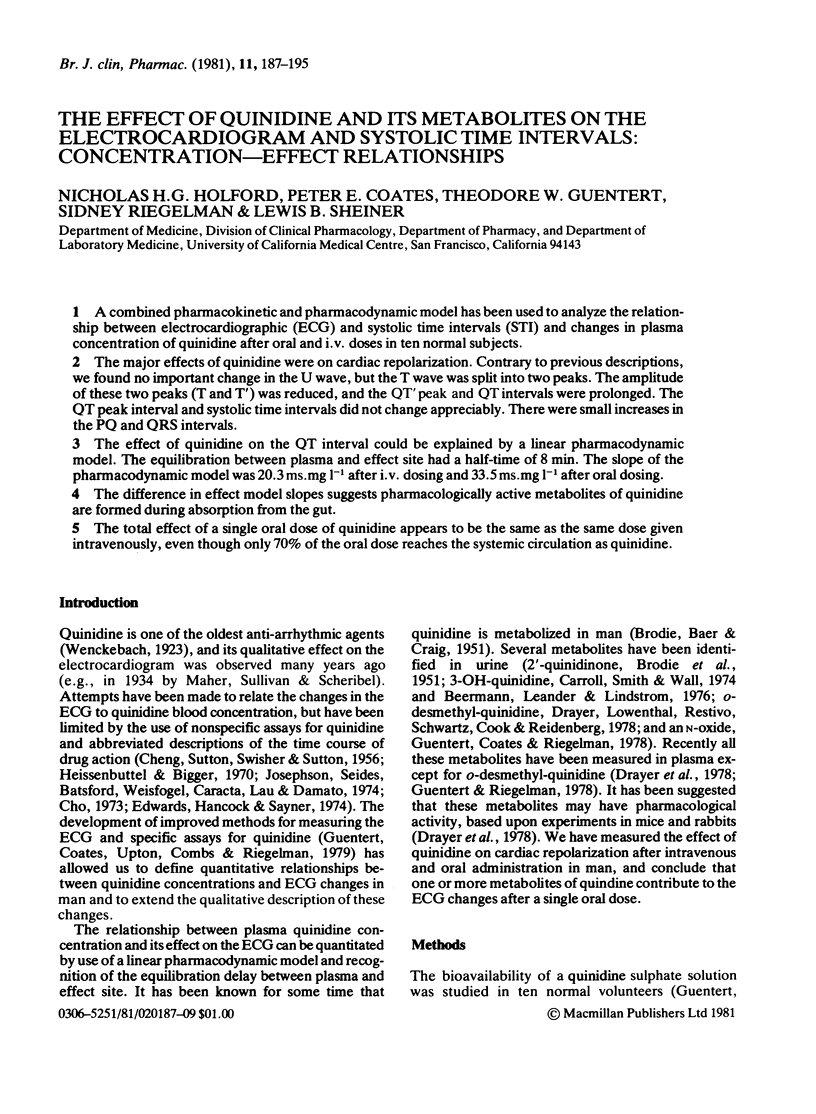
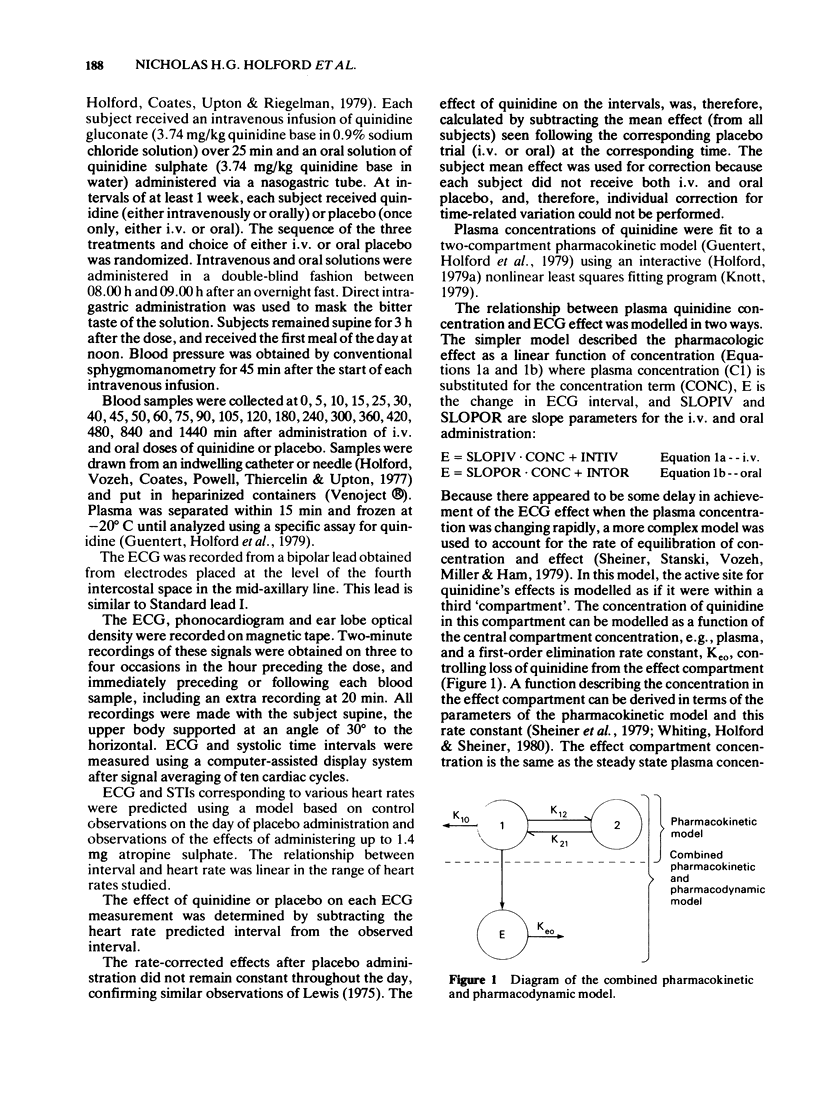
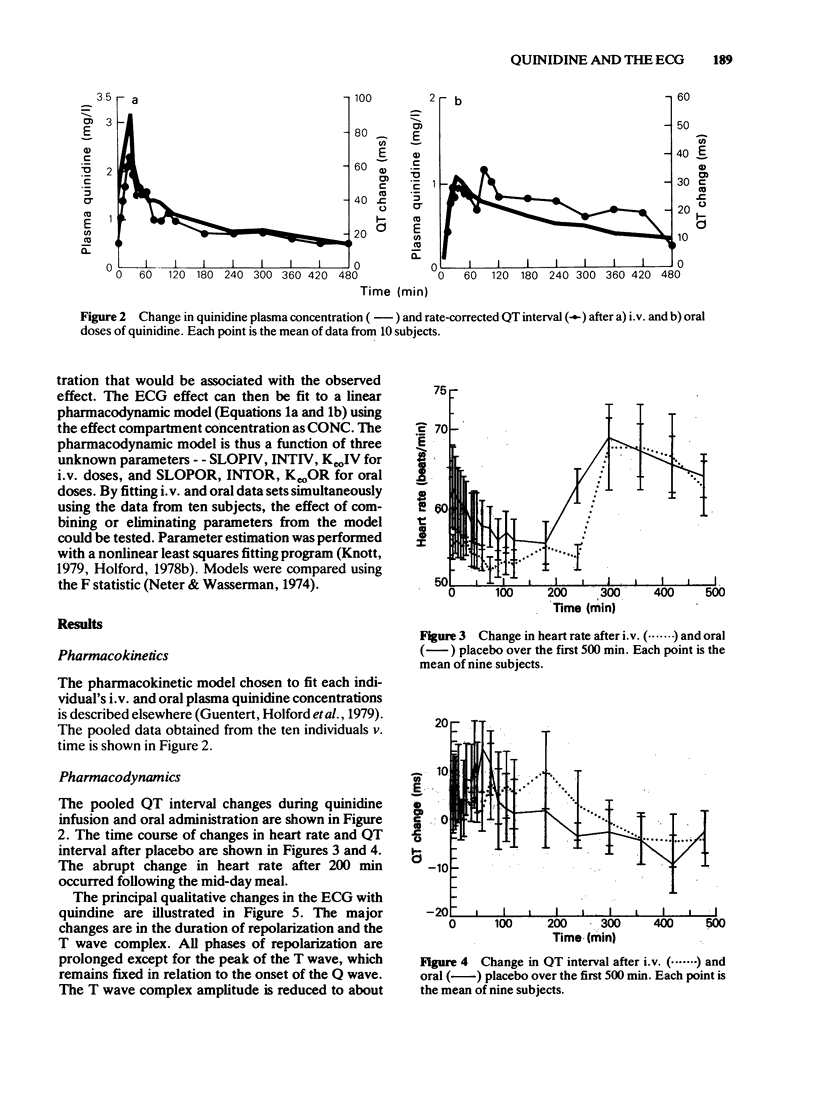
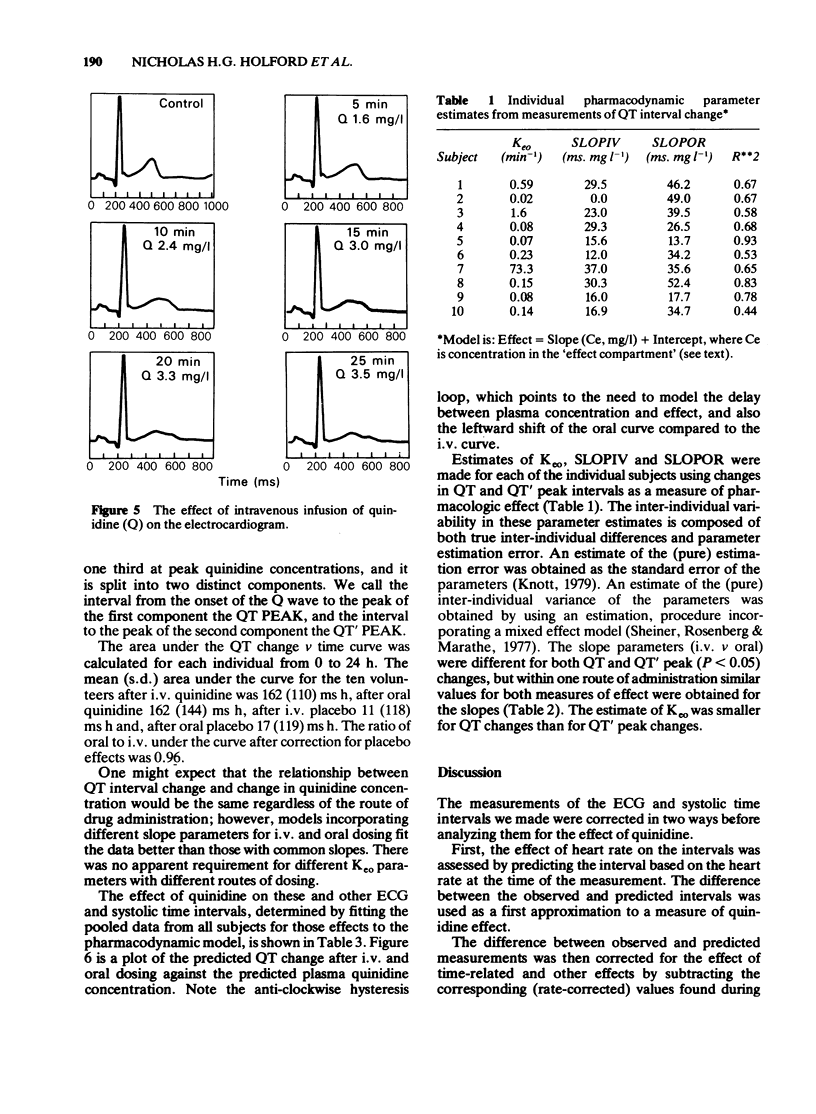
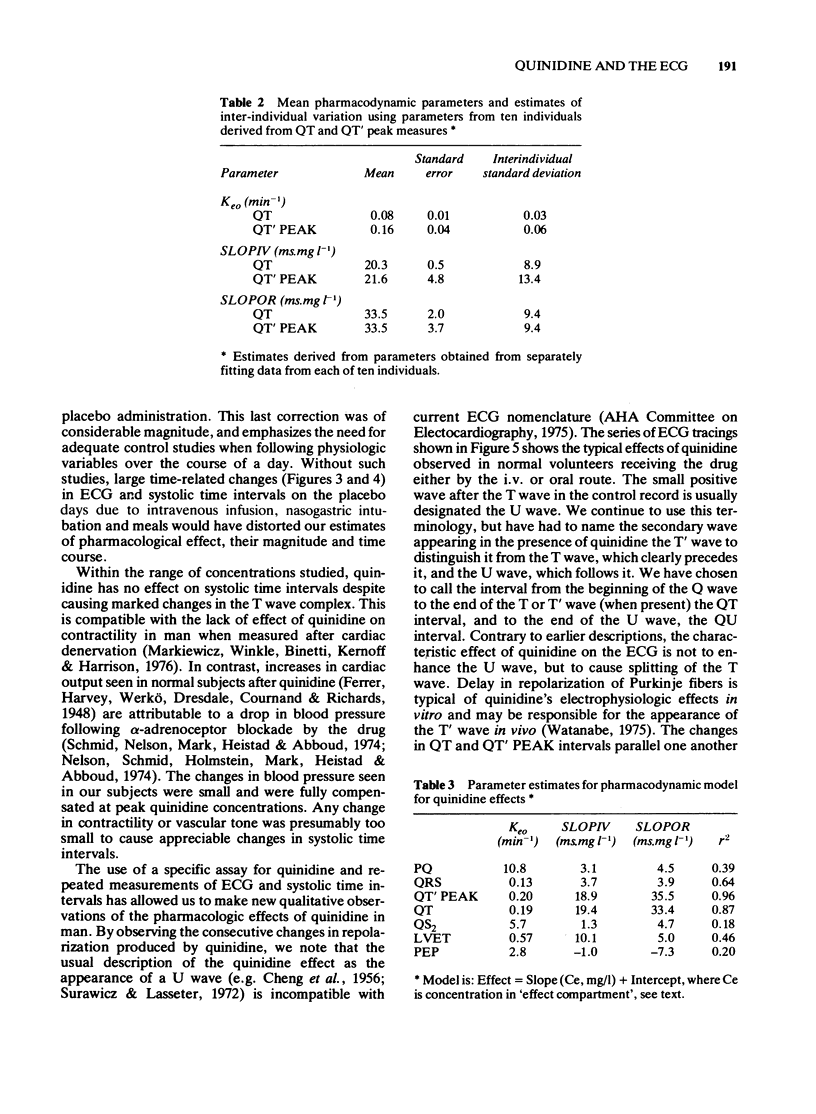
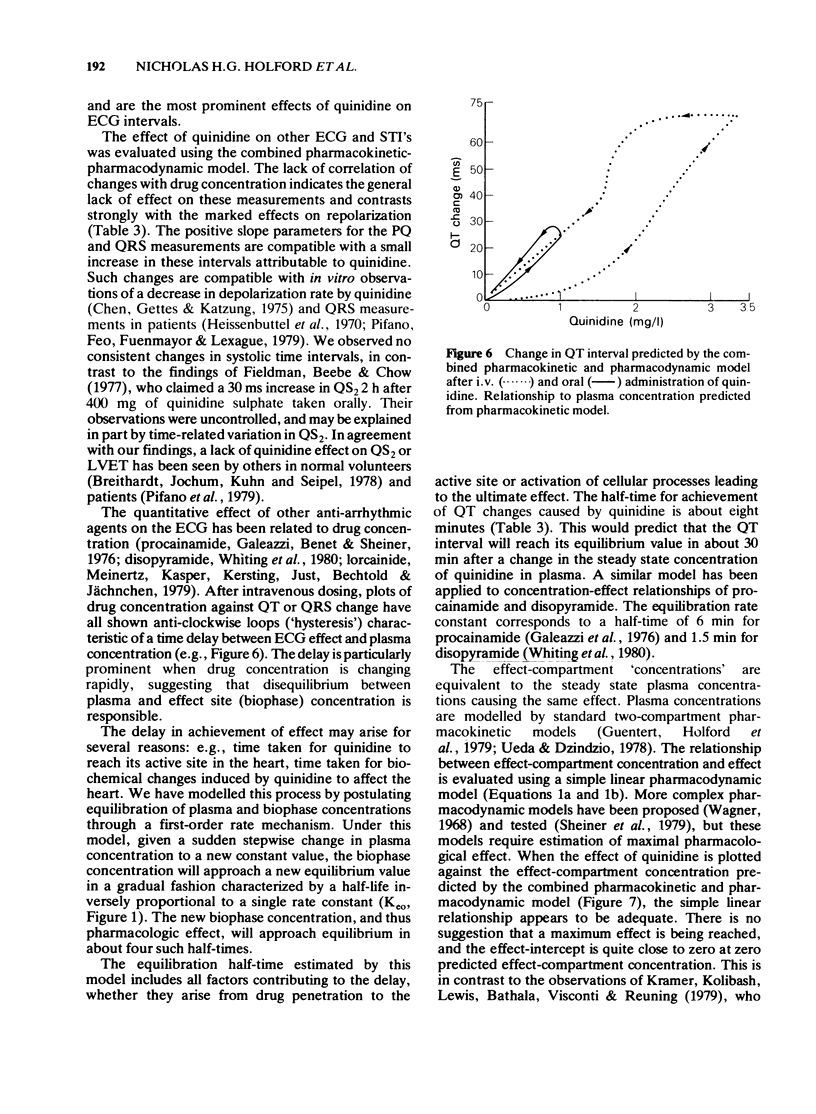
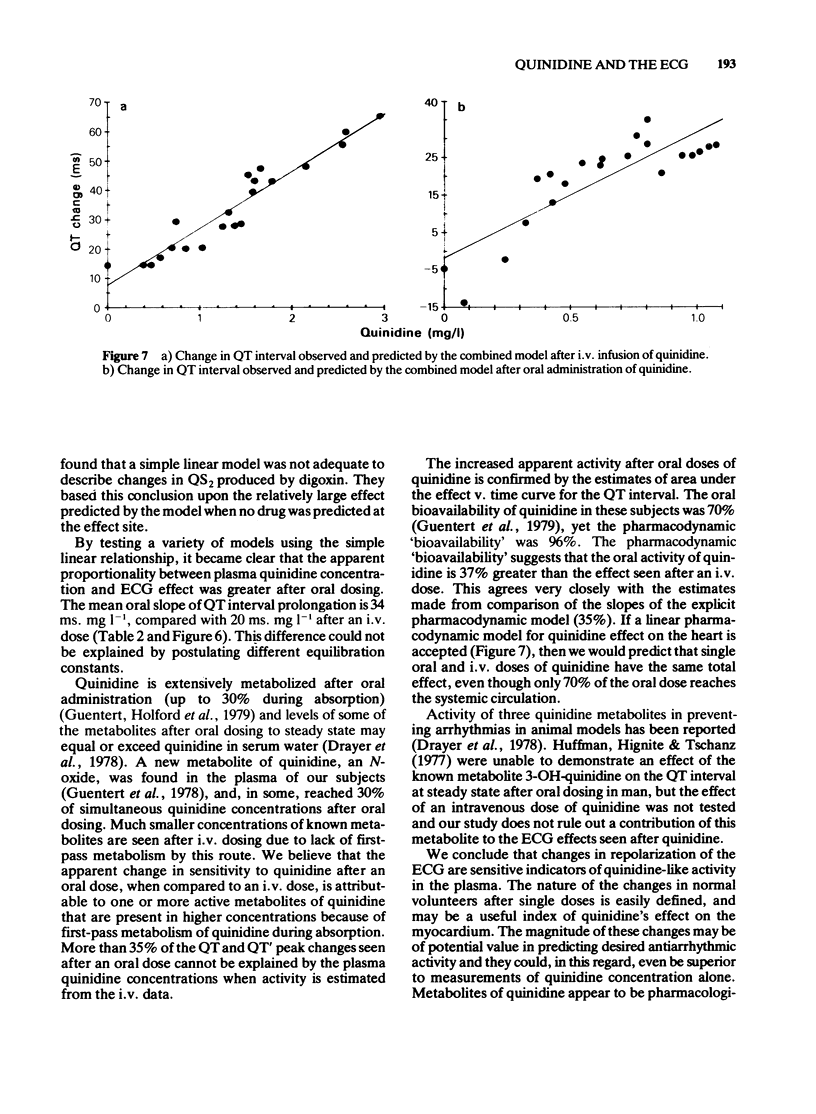
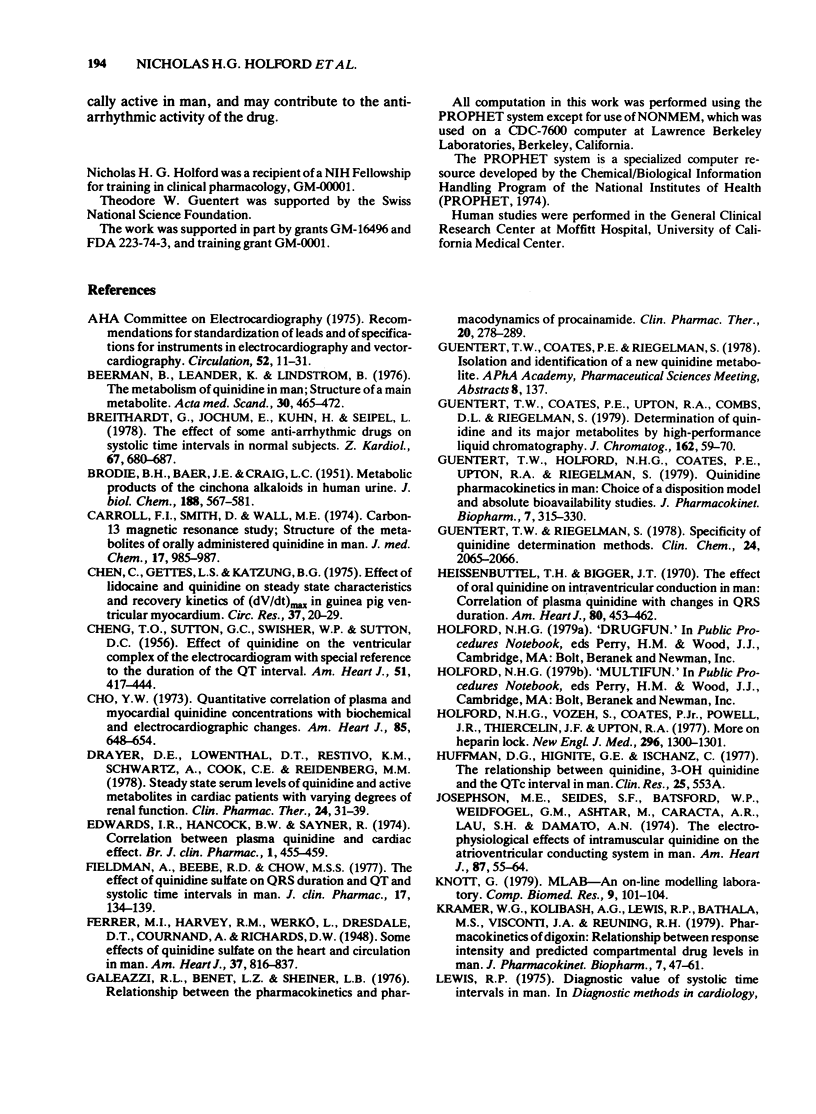
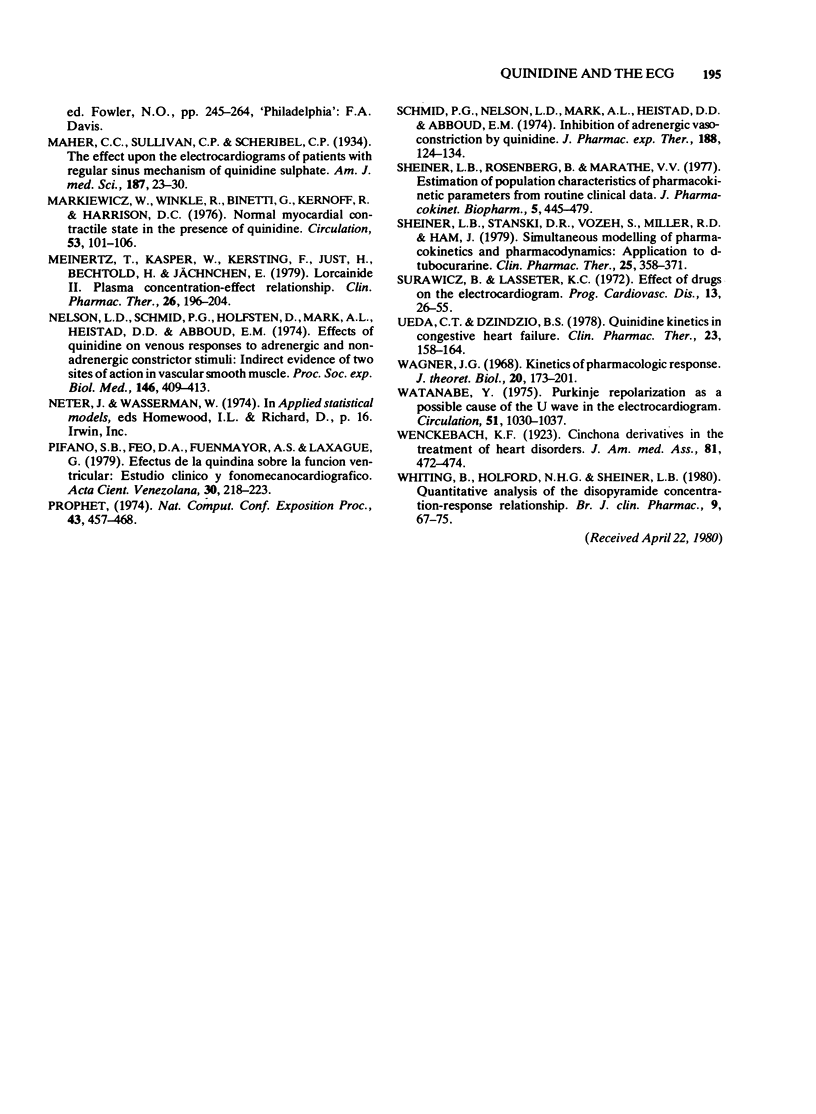
Selected References
These references are in PubMed. This may not be the complete list of references from this article.
- BRODIE B. B., BAER J. E., CRAIG L. C. Metabolic products of the cinchona alkaloids in human urine. J Biol Chem. 1951 Feb;188(2):567–581. [PubMed] [Google Scholar]
- Beermann B., Leander K., Lindström B. The metabolism of quinidine in man: structure of a main metabolite. Acta Chem Scand B. 1976;30(5):465–465. doi: 10.3891/acta.chem.scand.30b-0465. [DOI] [PubMed] [Google Scholar]
- Brandi Pifano S., Almeida Feo D., Salazar Fuenmayor A., Laxague G. Efectos de la quinidina sobre la función ventricular: estudio clínico y fonomecanocardiográfico. Acta Cient Venez. 1979;30(2):218–223. [PubMed] [Google Scholar]
- CHENG T. O., SUTTON G. C., SWISHER W. P., SUTTON D. C. Effect of quinidine on the ventricular complex of the electrocardiogram with special reference to the duration of the Q-T interval. Am Heart J. 1956 Mar;51(3):417–444. doi: 10.1016/0002-8703(56)90068-0. [DOI] [PubMed] [Google Scholar]
- Carroll F. I., Smith D., Wall M. E. Carbon-13 magnetic resonance study. Structure of the metabolites of orally administered quinidine in humans. J Med Chem. 1974 Sep;17(9):985–987. doi: 10.1021/jm00255a016. [DOI] [PubMed] [Google Scholar]
- Chen C. M., Gettes L. S., Katzung B. G. Effect of lidocaine and quinidine on steady-state characteristics and recovery kinetics of (dV/dt)max in guinea pig ventricular myocardium. Circ Res. 1975 Jul;37(1):20–29. doi: 10.1161/01.res.37.1.20. [DOI] [PubMed] [Google Scholar]
- Cho Y. W. Quantitative correlation of plasma and myocardial quinidine concentrations with biochemical and electrocardiographic changes. Am Heart J. 1973 May;85(5):648–654. doi: 10.1016/0002-8703(73)90170-1. [DOI] [PubMed] [Google Scholar]
- Drayer D. E., Lowenthal D. T., Restivo K. M., Schwartz A., Cook C. E., Reidenberg M. M. Steady-state serum levels of quinidine and active metabolites in cardiac patients with varying degrees of renal function. Clin Pharmacol Ther. 1978 Jul;24(1):31–39. doi: 10.1002/cpt197824131. [DOI] [PubMed] [Google Scholar]
- Fieldman A., Beebe R. D., Sing Sum Chow M. The effect of quinidine sulfate on QRS duration and QT and systolic time intervals in man. J Clin Pharmacol. 1977 Feb-Mar;17(2-3):134–139. doi: 10.1002/j.1552-4604.1977.tb04600.x. [DOI] [PubMed] [Google Scholar]
- Galeazzi R. L., Benet L. Z., Sheiner L. B. Relationship between the pharmacokinetics and pharmacodynamics of procainamide. Clin Pharmacol Ther. 1976 Sep;20(3):278–289. doi: 10.1002/cpt1976203278. [DOI] [PubMed] [Google Scholar]
- Guentert T. W., Coates P. E., Upton R. A., Combs D. L., Riegelman S. Determination of quinidine and its major metabolites by high-performance liquid chromatography. J Chromatogr. 1979 Jan 1;162(1):59–70. doi: 10.1016/s0378-4347(00)82063-0. [DOI] [PubMed] [Google Scholar]
- Guentert T. W., Holford N. H., Coates P. E., Upton R. A., Riegelman S. Quinidine pharmacokinetics in man: choice of a disposition model and absolute bioavailability studies. J Pharmacokinet Biopharm. 1979 Aug;7(4):315–330. doi: 10.1007/BF01062532. [DOI] [PubMed] [Google Scholar]
- Guentert T. W., Riegelman S. Specificity of quinidine determination methods. Clin Chem. 1978 Nov;24(11):2065–2066. [PubMed] [Google Scholar]
- Heissenbuttel R. H., Bigger J. T., Jr The effect of oral quinidine on intraventricular conduction in man: correlation of plasma quinidine with changes in QRS duration. Am Heart J. 1970 Oct;80(4):453–462. doi: 10.1016/0002-8703(70)90191-2. [DOI] [PubMed] [Google Scholar]
- Holford N. H., Vozeh S., Coates P., Powell J. R., Thiercelin J. F., Upton R. More on heparin lock. N Engl J Med. 1977 Jun 2;296(22):1300–1301. doi: 10.1056/NEJM197706022962223. [DOI] [PubMed] [Google Scholar]
- Josephson M. E., Seides S. F., Batsford W. P., Weisfogel G. M., Akhtar M., Caracta A. R., Lau S. H., Damato A. N. The electrophysiological effects of intramuscular guinidine on the atrioventricular conducting system in man. Am Heart J. 1974 Jan;87(1):55–64. doi: 10.1016/0002-8703(74)90391-3. [DOI] [PubMed] [Google Scholar]
- Kramer W. G., Kolibash A. J., Lewis R. P., Bathala M. S., Visconti J. A., Reuning R. H. Pharmacokinetics of digoxin: relationship between response intensity and predicted compartmental drug levels in man. J Pharmacokinet Biopharm. 1979 Feb;7(1):47–61. doi: 10.1007/BF01059440. [DOI] [PubMed] [Google Scholar]
- Markiewicz W., Winkle R., Binetti G., Kernoff R., Harrison D. C. Normal myocardial contractile state in the presence of quinidine. Circulation. 1976 Jan;53(1):101–106. doi: 10.1161/01.cir.53.1.101. [DOI] [PubMed] [Google Scholar]
- Meinertz T., Kasper W., Kersting F., Just H., Bechtold H., Jähnchen E. Lorcainide. II. Plasma concentration-effect relationship. Clin Pharmacol Ther. 1979 Aug;26(2):196–204. doi: 10.1002/cpt1979262196. [DOI] [PubMed] [Google Scholar]
- Nelson L. D., Schmid P. G., Holmsten D., Mark A. L., Heistad D. D., Abboud F. M. Effects of quinidine on venous responses to adrenergic and nonadrenergic constrictor stimuli: indirect evidence of two sites of action in vascular smooth muscle. Proc Soc Exp Biol Med. 1974 Jun;146(2):409–413. doi: 10.3181/00379727-146-38116. [DOI] [PubMed] [Google Scholar]
- Schmid P. G., Nelson L. D., Mark A. L., Heistad D. D., Abboud F. M. Inhibition of adrenergic vasoconstriction by quinidine. J Pharmacol Exp Ther. 1974 Jan;188(1):124–134. [PubMed] [Google Scholar]
- Sheiner L. B., Rosenberg B., Marathe V. V. Estimation of population characteristics of pharmacokinetic parameters from routine clinical data. J Pharmacokinet Biopharm. 1977 Oct;5(5):445–479. doi: 10.1007/BF01061728. [DOI] [PubMed] [Google Scholar]
- Sheiner L. B., Stanski D. R., Vozeh S., Miller R. D., Ham J. Simultaneous modeling of pharmacokinetics and pharmacodynamics: application to d-tubocurarine. Clin Pharmacol Ther. 1979 Mar;25(3):358–371. doi: 10.1002/cpt1979253358. [DOI] [PubMed] [Google Scholar]
- Ueda C. T., Dzindzio B. S. Quinidine kinetics in congestive heart failure. Clin Pharmacol Ther. 1978 Feb;23(2):158–164. doi: 10.1002/cpt1978232158. [DOI] [PubMed] [Google Scholar]
- Wagner J. G. Kinetics of pharmacologic response. I. Proposed relationships between response and drug concentration in the intact animal and man. J Theor Biol. 1968 Aug;20(2):173–201. doi: 10.1016/0022-5193(68)90188-4. [DOI] [PubMed] [Google Scholar]
- Watanabe Y. Purkinje repolarization as a possible cause of the U wave in the electrocardiogram. Circulation. 1975 Jun;51(6):1030–1037. doi: 10.1161/01.cir.51.6.1030. [DOI] [PubMed] [Google Scholar]
- Whiting B., Holford N. H., Sheiner L. B. Quantitative analysis of the disopyramide concentration-effect relationship. Br J Clin Pharmacol. 1980 Jan;9(1):67–75. doi: 10.1111/j.1365-2125.1980.tb04799.x. [DOI] [PMC free article] [PubMed] [Google Scholar]


